BUS5KMS: Analyzing KM Tools, Models, and Culture in Organizations
VerifiedAdded on 2023/06/13
|16
|3066
|172
Report
AI Summary
This report provides a critical analysis of knowledge management systems, focusing on KM tools, techniques, models, and processes within organizations. It examines organizational learning, knowledge sharing, trust, communities of practice, and the application of knowledge for innovation and new knowledge creation. The report also discusses the interplay between KM and organizational culture, KM governance, and organizational memory. It evaluates the outcomes of KM implementation, comparing them against theoretical aspects discussed in lectures, and incorporates relevant literature to support the analysis.
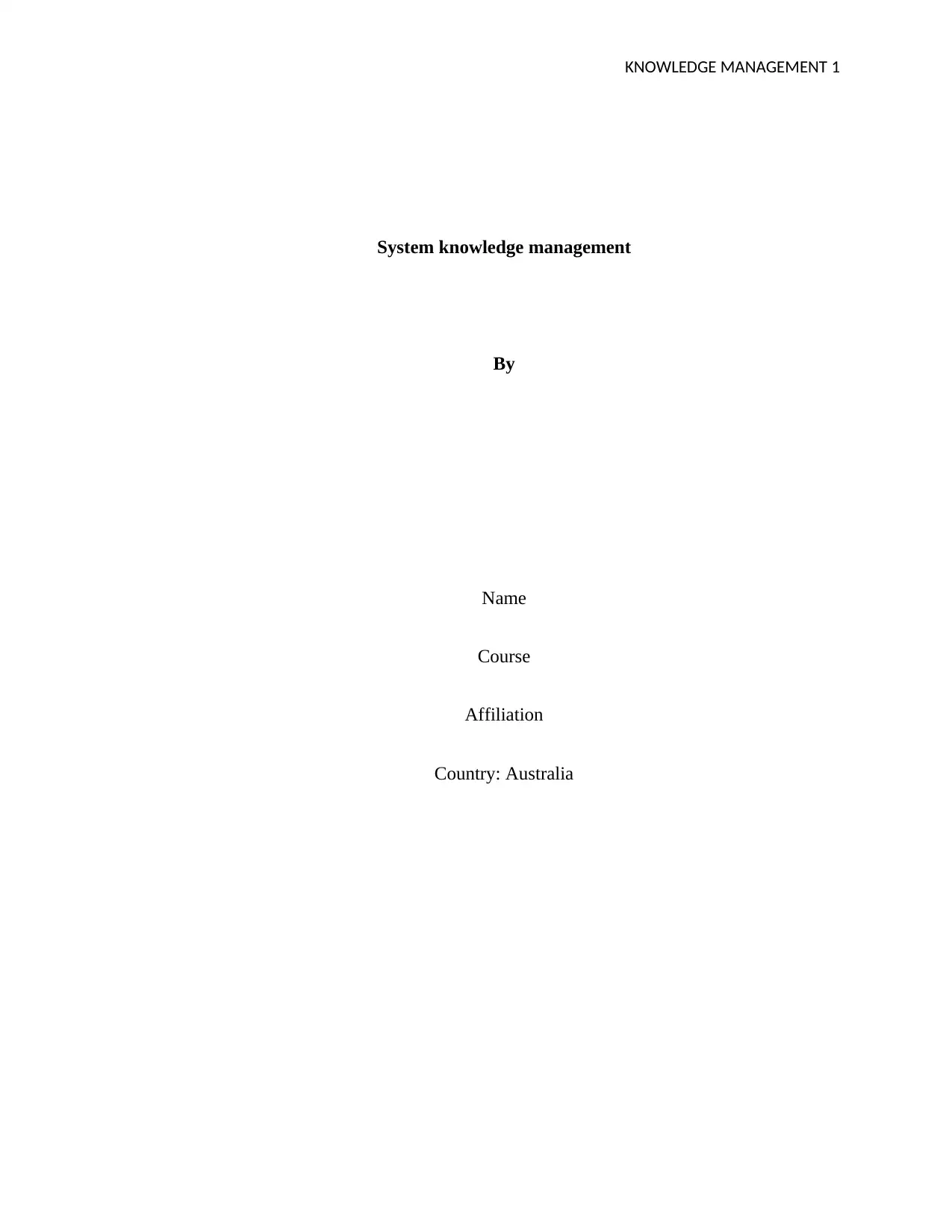
KNOWLEDGE MANAGEMENT 1
System knowledge management
By
Name
Course
Affiliation
Country: Australia
System knowledge management
By
Name
Course
Affiliation
Country: Australia
Paraphrase This Document
Need a fresh take? Get an instant paraphrase of this document with our AI Paraphraser
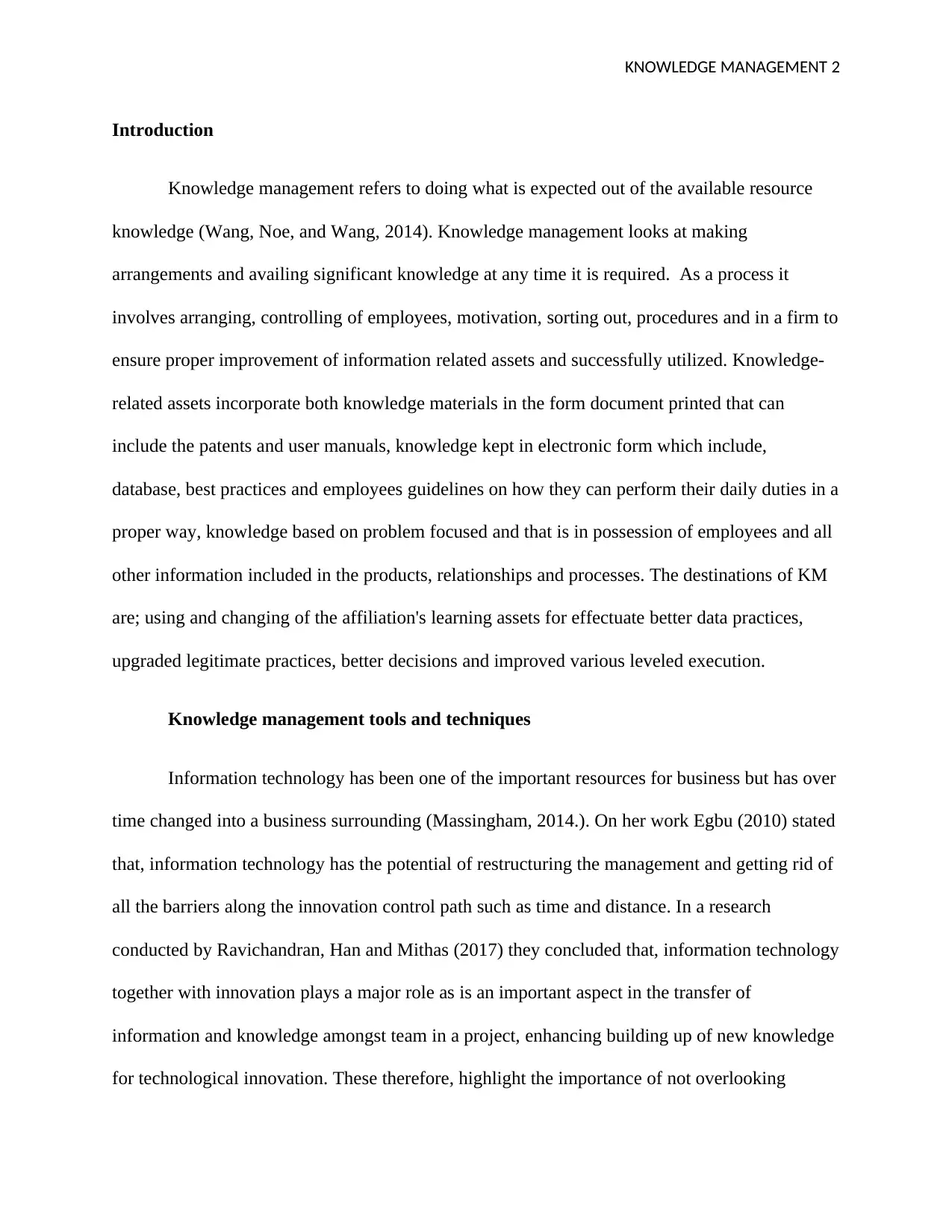
KNOWLEDGE MANAGEMENT 2
Introduction
Knowledge management refers to doing what is expected out of the available resource
knowledge (Wang, Noe, and Wang, 2014). Knowledge management looks at making
arrangements and availing significant knowledge at any time it is required. As a process it
involves arranging, controlling of employees, motivation, sorting out, procedures and in a firm to
ensure proper improvement of information related assets and successfully utilized. Knowledge-
related assets incorporate both knowledge materials in the form document printed that can
include the patents and user manuals, knowledge kept in electronic form which include,
database, best practices and employees guidelines on how they can perform their daily duties in a
proper way, knowledge based on problem focused and that is in possession of employees and all
other information included in the products, relationships and processes. The destinations of KM
are; using and changing of the affiliation's learning assets for effectuate better data practices,
upgraded legitimate practices, better decisions and improved various leveled execution.
Knowledge management tools and techniques
Information technology has been one of the important resources for business but has over
time changed into a business surrounding (Massingham, 2014.). On her work Egbu (2010) stated
that, information technology has the potential of restructuring the management and getting rid of
all the barriers along the innovation control path such as time and distance. In a research
conducted by Ravichandran, Han and Mithas (2017) they concluded that, information technology
together with innovation plays a major role as is an important aspect in the transfer of
information and knowledge amongst team in a project, enhancing building up of new knowledge
for technological innovation. These therefore, highlight the importance of not overlooking
Introduction
Knowledge management refers to doing what is expected out of the available resource
knowledge (Wang, Noe, and Wang, 2014). Knowledge management looks at making
arrangements and availing significant knowledge at any time it is required. As a process it
involves arranging, controlling of employees, motivation, sorting out, procedures and in a firm to
ensure proper improvement of information related assets and successfully utilized. Knowledge-
related assets incorporate both knowledge materials in the form document printed that can
include the patents and user manuals, knowledge kept in electronic form which include,
database, best practices and employees guidelines on how they can perform their daily duties in a
proper way, knowledge based on problem focused and that is in possession of employees and all
other information included in the products, relationships and processes. The destinations of KM
are; using and changing of the affiliation's learning assets for effectuate better data practices,
upgraded legitimate practices, better decisions and improved various leveled execution.
Knowledge management tools and techniques
Information technology has been one of the important resources for business but has over
time changed into a business surrounding (Massingham, 2014.). On her work Egbu (2010) stated
that, information technology has the potential of restructuring the management and getting rid of
all the barriers along the innovation control path such as time and distance. In a research
conducted by Ravichandran, Han and Mithas (2017) they concluded that, information technology
together with innovation plays a major role as is an important aspect in the transfer of
information and knowledge amongst team in a project, enhancing building up of new knowledge
for technological innovation. These therefore, highlight the importance of not overlooking
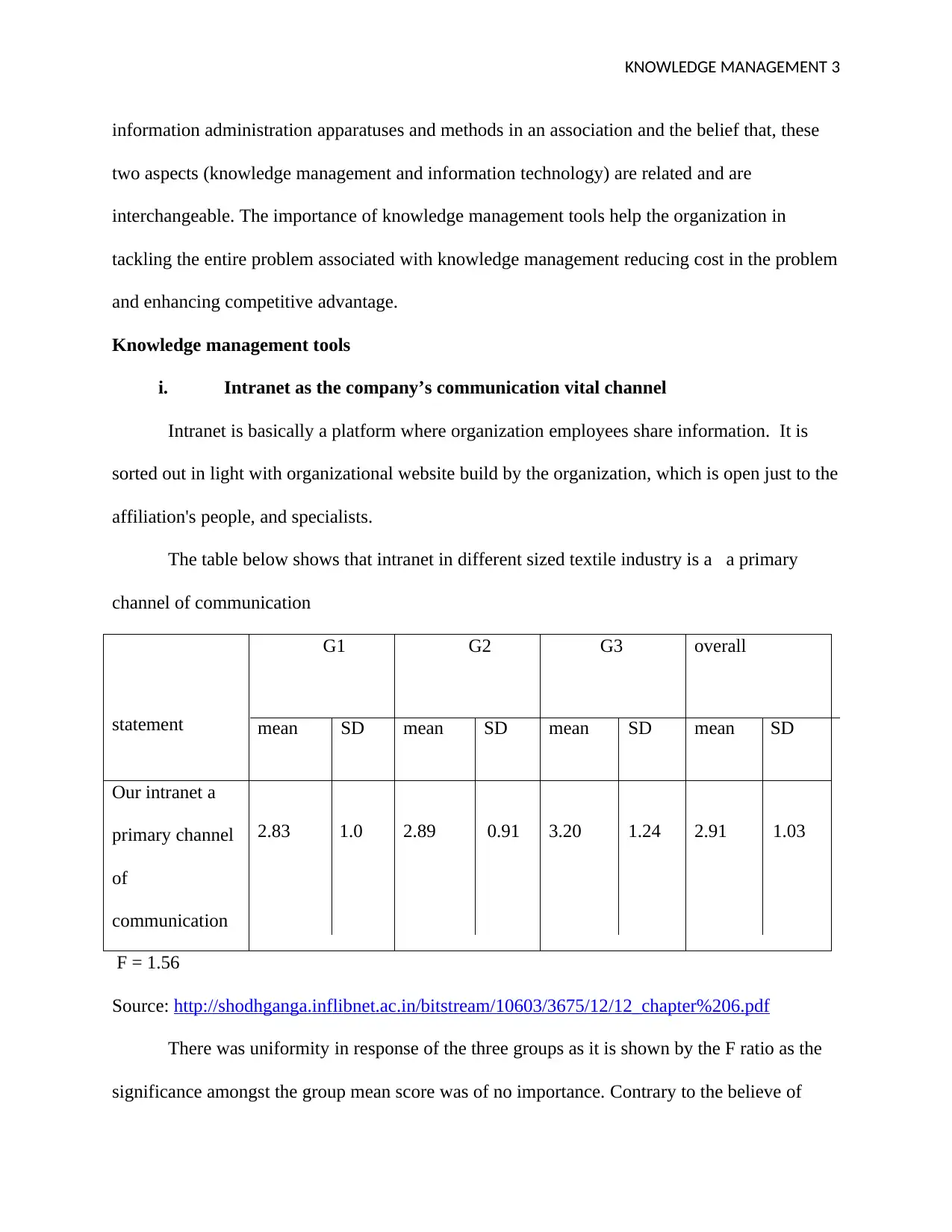
KNOWLEDGE MANAGEMENT 3
information administration apparatuses and methods in an association and the belief that, these
two aspects (knowledge management and information technology) are related and are
interchangeable. The importance of knowledge management tools help the organization in
tackling the entire problem associated with knowledge management reducing cost in the problem
and enhancing competitive advantage.
Knowledge management tools
i. Intranet as the company’s communication vital channel
Intranet is basically a platform where organization employees share information. It is
sorted out in light with organizational website build by the organization, which is open just to the
affiliation's people, and specialists.
The table below shows that intranet in different sized textile industry is a a primary
channel of communication
statement
G1
mean SD
G2
mean SD
G3
mean SD
overall
mean SD
Our intranet a
primary channel
of
communication
2.83 1.0 2.89 0.91 3.20 1.24 2.91 1.03
F = 1.56
Source: http://shodhganga.inflibnet.ac.in/bitstream/10603/3675/12/12_chapter%206.pdf
There was uniformity in response of the three groups as it is shown by the F ratio as the
significance amongst the group mean score was of no importance. Contrary to the believe of
information administration apparatuses and methods in an association and the belief that, these
two aspects (knowledge management and information technology) are related and are
interchangeable. The importance of knowledge management tools help the organization in
tackling the entire problem associated with knowledge management reducing cost in the problem
and enhancing competitive advantage.
Knowledge management tools
i. Intranet as the company’s communication vital channel
Intranet is basically a platform where organization employees share information. It is
sorted out in light with organizational website build by the organization, which is open just to the
affiliation's people, and specialists.
The table below shows that intranet in different sized textile industry is a a primary
channel of communication
statement
G1
mean SD
G2
mean SD
G3
mean SD
overall
mean SD
Our intranet a
primary channel
of
communication
2.83 1.0 2.89 0.91 3.20 1.24 2.91 1.03
F = 1.56
Source: http://shodhganga.inflibnet.ac.in/bitstream/10603/3675/12/12_chapter%206.pdf
There was uniformity in response of the three groups as it is shown by the F ratio as the
significance amongst the group mean score was of no importance. Contrary to the believe of
⊘ This is a preview!⊘
Do you want full access?
Subscribe today to unlock all pages.

Trusted by 1+ million students worldwide
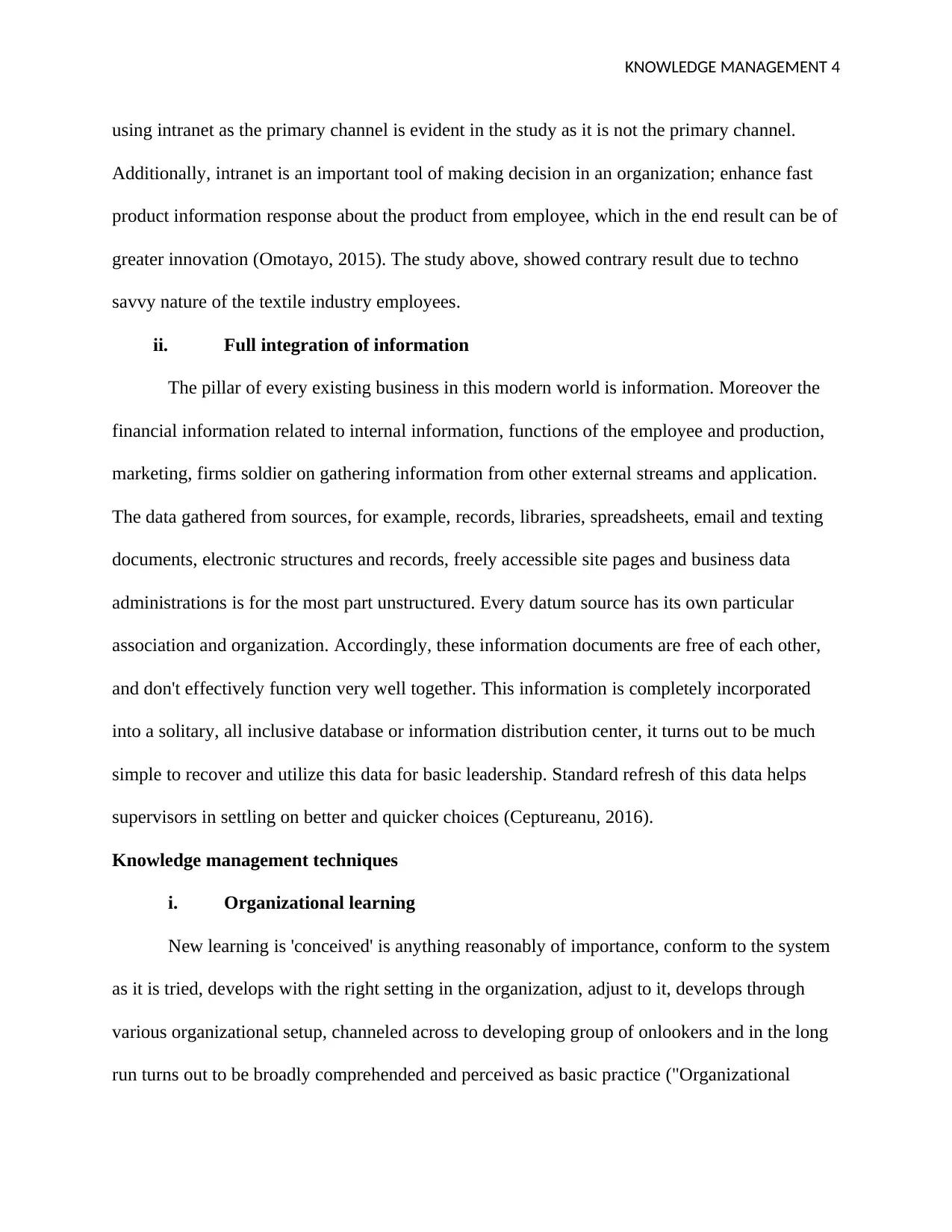
KNOWLEDGE MANAGEMENT 4
using intranet as the primary channel is evident in the study as it is not the primary channel.
Additionally, intranet is an important tool of making decision in an organization; enhance fast
product information response about the product from employee, which in the end result can be of
greater innovation (Omotayo, 2015). The study above, showed contrary result due to techno
savvy nature of the textile industry employees.
ii. Full integration of information
The pillar of every existing business in this modern world is information. Moreover the
financial information related to internal information, functions of the employee and production,
marketing, firms soldier on gathering information from other external streams and application.
The data gathered from sources, for example, records, libraries, spreadsheets, email and texting
documents, electronic structures and records, freely accessible site pages and business data
administrations is for the most part unstructured. Every datum source has its own particular
association and organization. Accordingly, these information documents are free of each other,
and don't effectively function very well together. This information is completely incorporated
into a solitary, all inclusive database or information distribution center, it turns out to be much
simple to recover and utilize this data for basic leadership. Standard refresh of this data helps
supervisors in settling on better and quicker choices (Ceptureanu, 2016).
Knowledge management techniques
i. Organizational learning
New learning is 'conceived' is anything reasonably of importance, conform to the system
as it is tried, develops with the right setting in the organization, adjust to it, develops through
various organizational setup, channeled across to developing group of onlookers and in the long
run turns out to be broadly comprehended and perceived as basic practice ("Organizational
using intranet as the primary channel is evident in the study as it is not the primary channel.
Additionally, intranet is an important tool of making decision in an organization; enhance fast
product information response about the product from employee, which in the end result can be of
greater innovation (Omotayo, 2015). The study above, showed contrary result due to techno
savvy nature of the textile industry employees.
ii. Full integration of information
The pillar of every existing business in this modern world is information. Moreover the
financial information related to internal information, functions of the employee and production,
marketing, firms soldier on gathering information from other external streams and application.
The data gathered from sources, for example, records, libraries, spreadsheets, email and texting
documents, electronic structures and records, freely accessible site pages and business data
administrations is for the most part unstructured. Every datum source has its own particular
association and organization. Accordingly, these information documents are free of each other,
and don't effectively function very well together. This information is completely incorporated
into a solitary, all inclusive database or information distribution center, it turns out to be much
simple to recover and utilize this data for basic leadership. Standard refresh of this data helps
supervisors in settling on better and quicker choices (Ceptureanu, 2016).
Knowledge management techniques
i. Organizational learning
New learning is 'conceived' is anything reasonably of importance, conform to the system
as it is tried, develops with the right setting in the organization, adjust to it, develops through
various organizational setup, channeled across to developing group of onlookers and in the long
run turns out to be broadly comprehended and perceived as basic practice ("Organizational
Paraphrase This Document
Need a fresh take? Get an instant paraphrase of this document with our AI Paraphraser
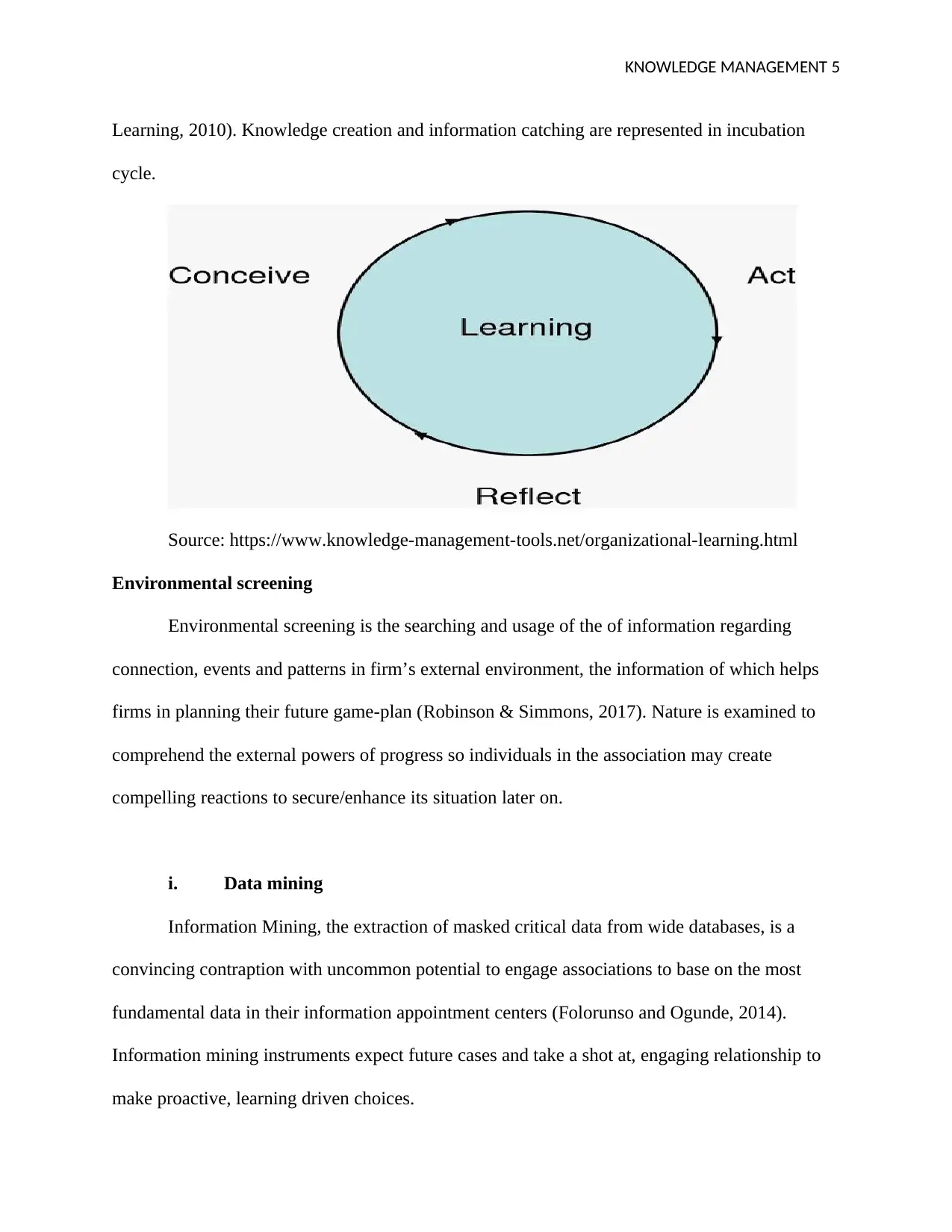
KNOWLEDGE MANAGEMENT 5
Learning, 2010). Knowledge creation and information catching are represented in incubation
cycle.
Source: https://www.knowledge-management-tools.net/organizational-learning.html
Environmental screening
Environmental screening is the searching and usage of the of information regarding
connection, events and patterns in firm’s external environment, the information of which helps
firms in planning their future game-plan (Robinson & Simmons, 2017). Nature is examined to
comprehend the external powers of progress so individuals in the association may create
compelling reactions to secure/enhance its situation later on.
i. Data mining
Information Mining, the extraction of masked critical data from wide databases, is a
convincing contraption with uncommon potential to engage associations to base on the most
fundamental data in their information appointment centers (Folorunso and Ogunde, 2014).
Information mining instruments expect future cases and take a shot at, engaging relationship to
make proactive, learning driven choices.
Learning, 2010). Knowledge creation and information catching are represented in incubation
cycle.
Source: https://www.knowledge-management-tools.net/organizational-learning.html
Environmental screening
Environmental screening is the searching and usage of the of information regarding
connection, events and patterns in firm’s external environment, the information of which helps
firms in planning their future game-plan (Robinson & Simmons, 2017). Nature is examined to
comprehend the external powers of progress so individuals in the association may create
compelling reactions to secure/enhance its situation later on.
i. Data mining
Information Mining, the extraction of masked critical data from wide databases, is a
convincing contraption with uncommon potential to engage associations to base on the most
fundamental data in their information appointment centers (Folorunso and Ogunde, 2014).
Information mining instruments expect future cases and take a shot at, engaging relationship to
make proactive, learning driven choices.
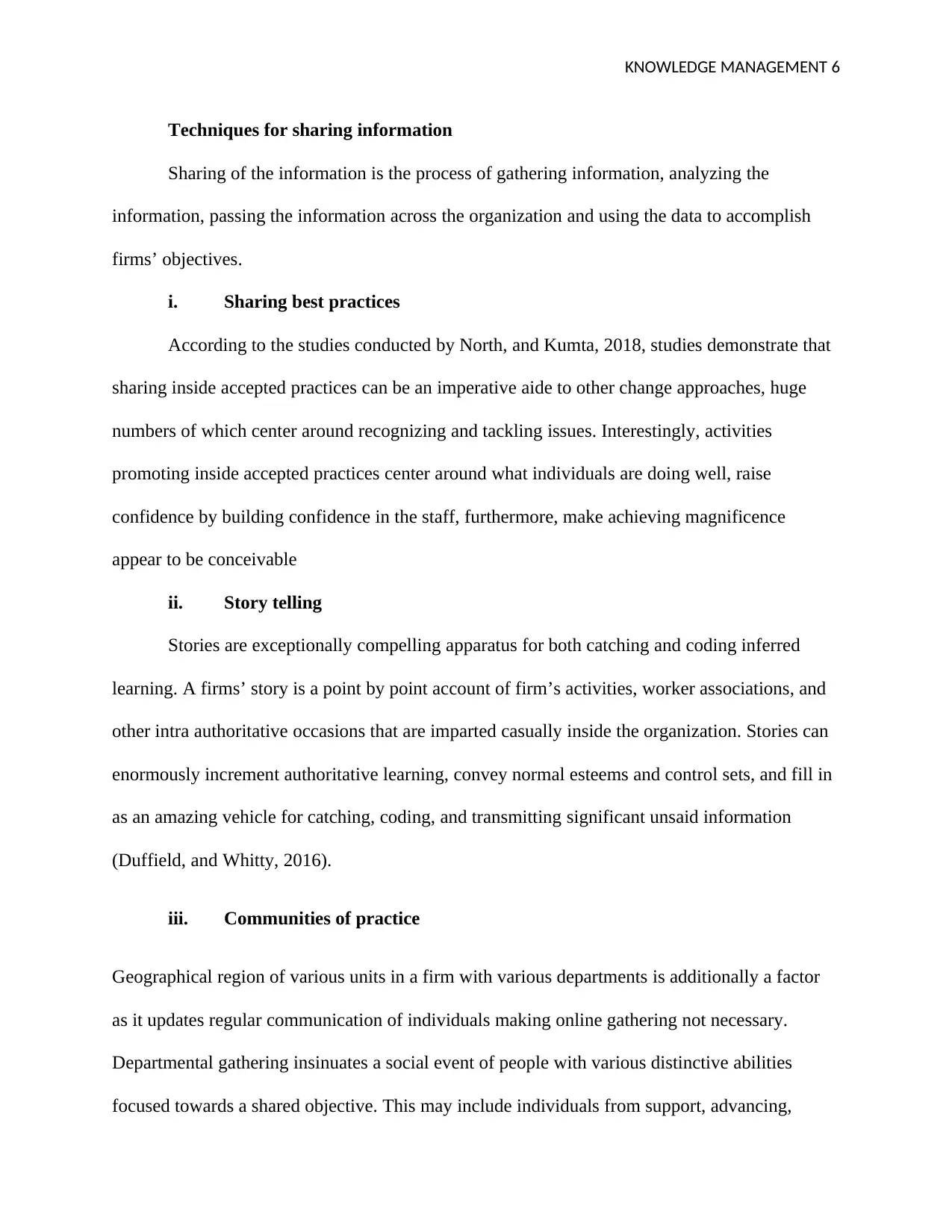
KNOWLEDGE MANAGEMENT 6
Techniques for sharing information
Sharing of the information is the process of gathering information, analyzing the
information, passing the information across the organization and using the data to accomplish
firms’ objectives.
i. Sharing best practices
According to the studies conducted by North, and Kumta, 2018, studies demonstrate that
sharing inside accepted practices can be an imperative aide to other change approaches, huge
numbers of which center around recognizing and tackling issues. Interestingly, activities
promoting inside accepted practices center around what individuals are doing well, raise
confidence by building confidence in the staff, furthermore, make achieving magnificence
appear to be conceivable
ii. Story telling
Stories are exceptionally compelling apparatus for both catching and coding inferred
learning. A firms’ story is a point by point account of firm’s activities, worker associations, and
other intra authoritative occasions that are imparted casually inside the organization. Stories can
enormously increment authoritative learning, convey normal esteems and control sets, and fill in
as an amazing vehicle for catching, coding, and transmitting significant unsaid information
(Duffield, and Whitty, 2016).
iii. Communities of practice
Geographical region of various units in a firm with various departments is additionally a factor
as it updates regular communication of individuals making online gathering not necessary.
Departmental gathering insinuates a social event of people with various distinctive abilities
focused towards a shared objective. This may include individuals from support, advancing,
Techniques for sharing information
Sharing of the information is the process of gathering information, analyzing the
information, passing the information across the organization and using the data to accomplish
firms’ objectives.
i. Sharing best practices
According to the studies conducted by North, and Kumta, 2018, studies demonstrate that
sharing inside accepted practices can be an imperative aide to other change approaches, huge
numbers of which center around recognizing and tackling issues. Interestingly, activities
promoting inside accepted practices center around what individuals are doing well, raise
confidence by building confidence in the staff, furthermore, make achieving magnificence
appear to be conceivable
ii. Story telling
Stories are exceptionally compelling apparatus for both catching and coding inferred
learning. A firms’ story is a point by point account of firm’s activities, worker associations, and
other intra authoritative occasions that are imparted casually inside the organization. Stories can
enormously increment authoritative learning, convey normal esteems and control sets, and fill in
as an amazing vehicle for catching, coding, and transmitting significant unsaid information
(Duffield, and Whitty, 2016).
iii. Communities of practice
Geographical region of various units in a firm with various departments is additionally a factor
as it updates regular communication of individuals making online gathering not necessary.
Departmental gathering insinuates a social event of people with various distinctive abilities
focused towards a shared objective. This may include individuals from support, advancing,
⊘ This is a preview!⊘
Do you want full access?
Subscribe today to unlock all pages.

Trusted by 1+ million students worldwide
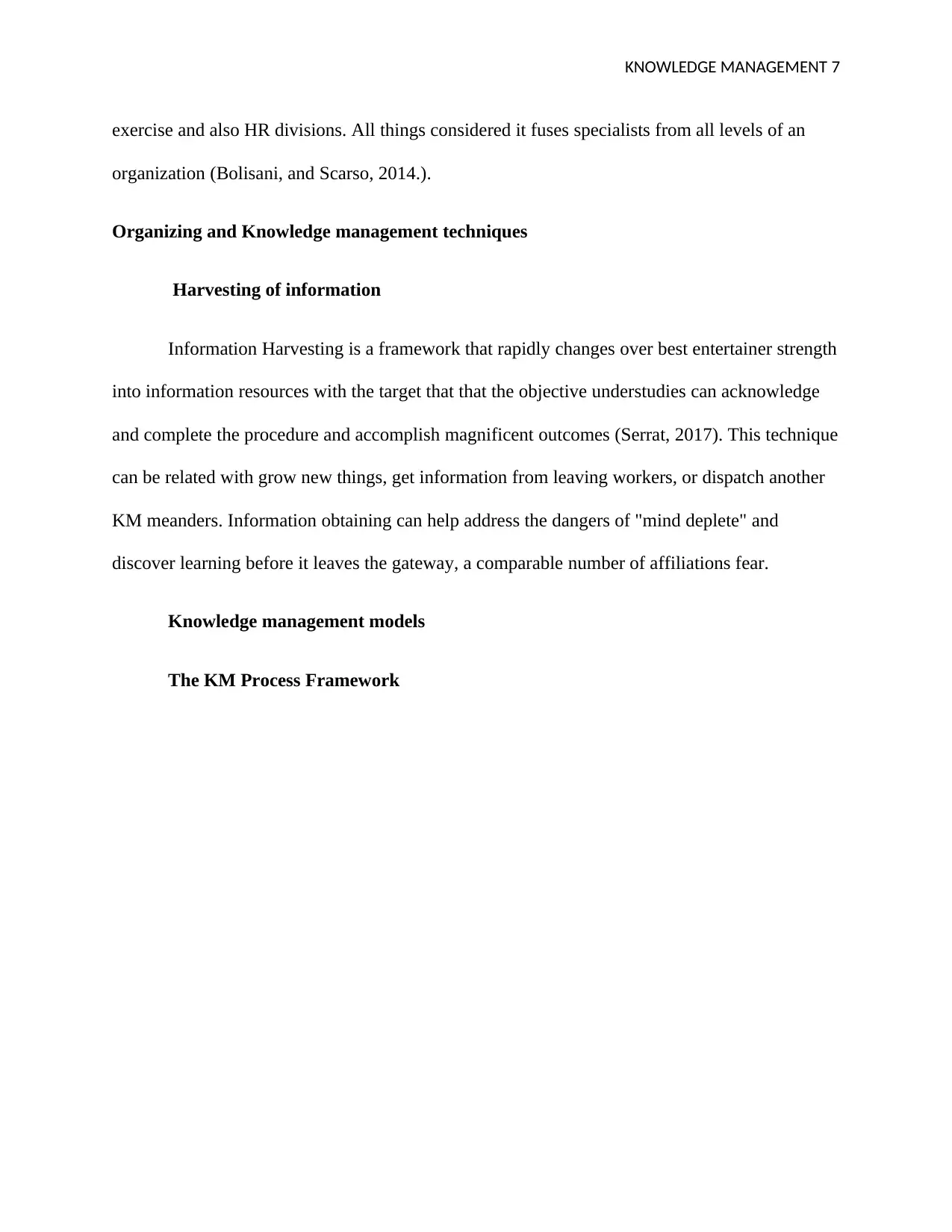
KNOWLEDGE MANAGEMENT 7
exercise and also HR divisions. All things considered it fuses specialists from all levels of an
organization (Bolisani, and Scarso, 2014.).
Organizing and Knowledge management techniques
Harvesting of information
Information Harvesting is a framework that rapidly changes over best entertainer strength
into information resources with the target that that the objective understudies can acknowledge
and complete the procedure and accomplish magnificent outcomes (Serrat, 2017). This technique
can be related with grow new things, get information from leaving workers, or dispatch another
KM meanders. Information obtaining can help address the dangers of "mind deplete" and
discover learning before it leaves the gateway, a comparable number of affiliations fear.
Knowledge management models
The KM Process Framework
exercise and also HR divisions. All things considered it fuses specialists from all levels of an
organization (Bolisani, and Scarso, 2014.).
Organizing and Knowledge management techniques
Harvesting of information
Information Harvesting is a framework that rapidly changes over best entertainer strength
into information resources with the target that that the objective understudies can acknowledge
and complete the procedure and accomplish magnificent outcomes (Serrat, 2017). This technique
can be related with grow new things, get information from leaving workers, or dispatch another
KM meanders. Information obtaining can help address the dangers of "mind deplete" and
discover learning before it leaves the gateway, a comparable number of affiliations fear.
Knowledge management models
The KM Process Framework
Paraphrase This Document
Need a fresh take? Get an instant paraphrase of this document with our AI Paraphraser
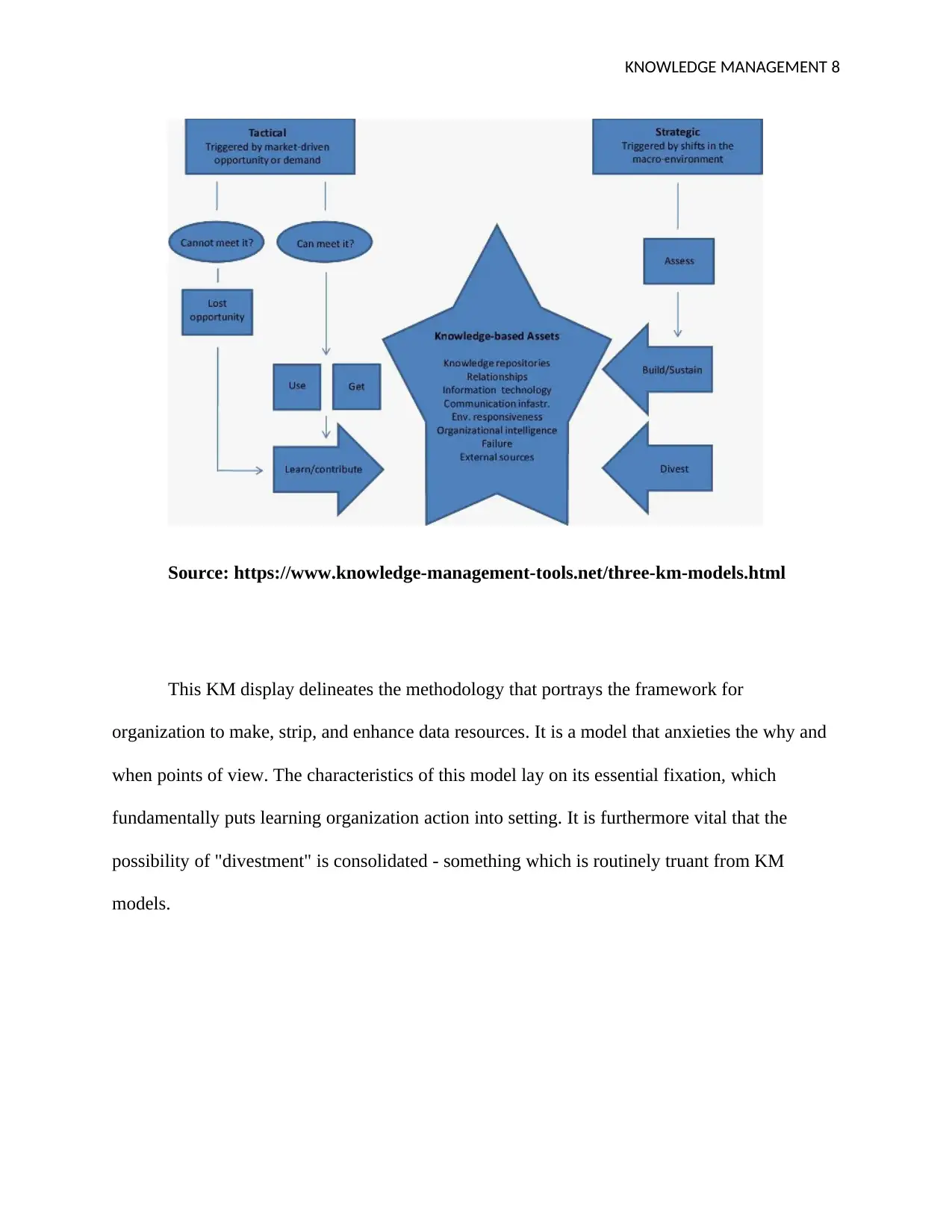
KNOWLEDGE MANAGEMENT 8
Source: https://www.knowledge-management-tools.net/three-km-models.html
This KM display delineates the methodology that portrays the framework for
organization to make, strip, and enhance data resources. It is a model that anxieties the why and
when points of view. The characteristics of this model lay on its essential fixation, which
fundamentally puts learning organization action into setting. It is furthermore vital that the
possibility of "divestment" is consolidated - something which is routinely truant from KM
models.
Source: https://www.knowledge-management-tools.net/three-km-models.html
This KM display delineates the methodology that portrays the framework for
organization to make, strip, and enhance data resources. It is a model that anxieties the why and
when points of view. The characteristics of this model lay on its essential fixation, which
fundamentally puts learning organization action into setting. It is furthermore vital that the
possibility of "divestment" is consolidated - something which is routinely truant from KM
models.
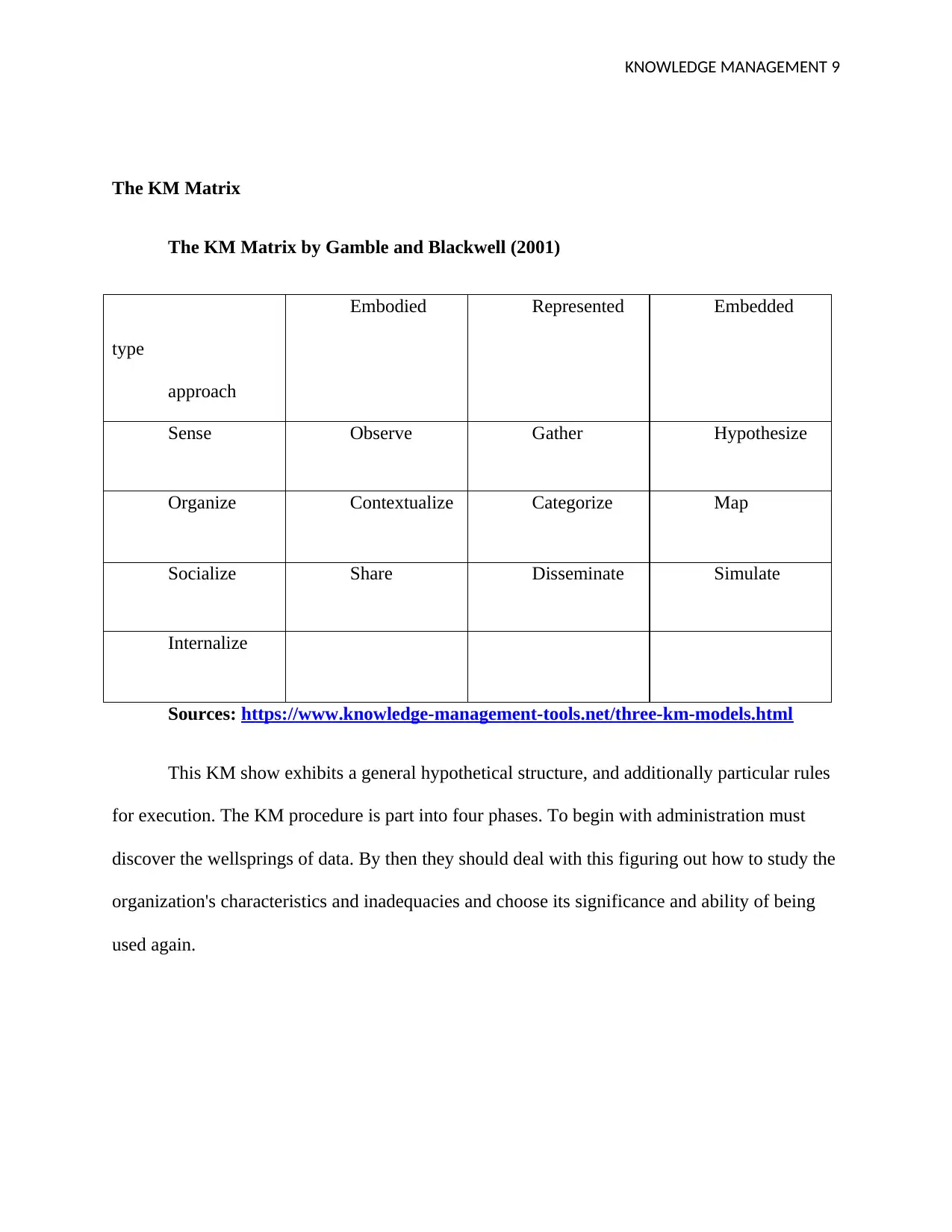
KNOWLEDGE MANAGEMENT 9
The KM Matrix
The KM Matrix by Gamble and Blackwell (2001)
type
approach
Embodied Represented Embedded
Sense Observe Gather Hypothesize
Organize Contextualize Categorize Map
Socialize Share Disseminate Simulate
Internalize
Sources: https://www.knowledge-management-tools.net/three-km-models.html
This KM show exhibits a general hypothetical structure, and additionally particular rules
for execution. The KM procedure is part into four phases. To begin with administration must
discover the wellsprings of data. By then they should deal with this figuring out how to study the
organization's characteristics and inadequacies and choose its significance and ability of being
used again.
The KM Matrix
The KM Matrix by Gamble and Blackwell (2001)
type
approach
Embodied Represented Embedded
Sense Observe Gather Hypothesize
Organize Contextualize Categorize Map
Socialize Share Disseminate Simulate
Internalize
Sources: https://www.knowledge-management-tools.net/three-km-models.html
This KM show exhibits a general hypothetical structure, and additionally particular rules
for execution. The KM procedure is part into four phases. To begin with administration must
discover the wellsprings of data. By then they should deal with this figuring out how to study the
organization's characteristics and inadequacies and choose its significance and ability of being
used again.
⊘ This is a preview!⊘
Do you want full access?
Subscribe today to unlock all pages.

Trusted by 1+ million students worldwide
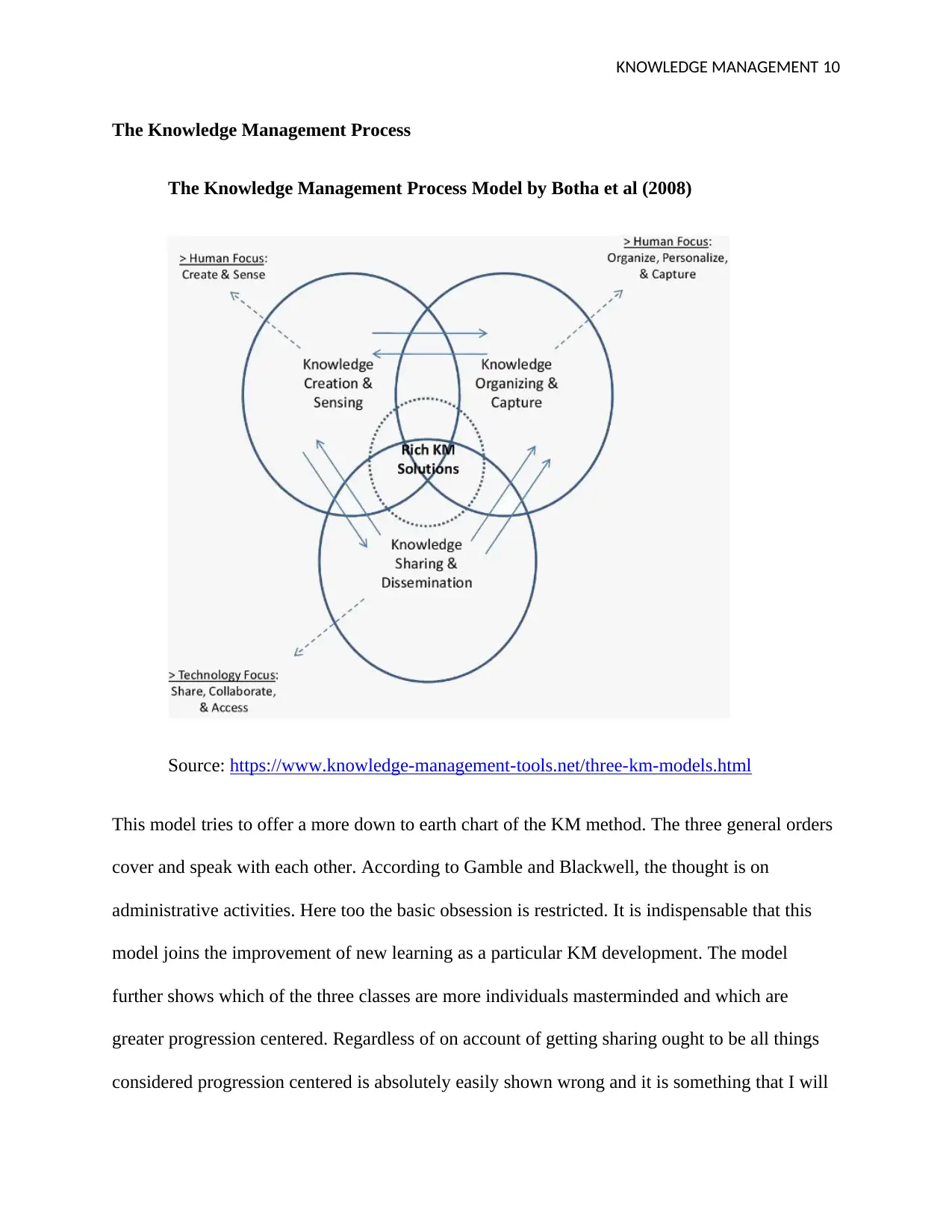
KNOWLEDGE MANAGEMENT 10
The Knowledge Management Process
The Knowledge Management Process Model by Botha et al (2008)
Source: https://www.knowledge-management-tools.net/three-km-models.html
This model tries to offer a more down to earth chart of the KM method. The three general orders
cover and speak with each other. According to Gamble and Blackwell, the thought is on
administrative activities. Here too the basic obsession is restricted. It is indispensable that this
model joins the improvement of new learning as a particular KM development. The model
further shows which of the three classes are more individuals masterminded and which are
greater progression centered. Regardless of on account of getting sharing ought to be all things
considered progression centered is absolutely easily shown wrong and it is something that I will
The Knowledge Management Process
The Knowledge Management Process Model by Botha et al (2008)
Source: https://www.knowledge-management-tools.net/three-km-models.html
This model tries to offer a more down to earth chart of the KM method. The three general orders
cover and speak with each other. According to Gamble and Blackwell, the thought is on
administrative activities. Here too the basic obsession is restricted. It is indispensable that this
model joins the improvement of new learning as a particular KM development. The model
further shows which of the three classes are more individuals masterminded and which are
greater progression centered. Regardless of on account of getting sharing ought to be all things
considered progression centered is absolutely easily shown wrong and it is something that I will
Paraphrase This Document
Need a fresh take? Get an instant paraphrase of this document with our AI Paraphraser
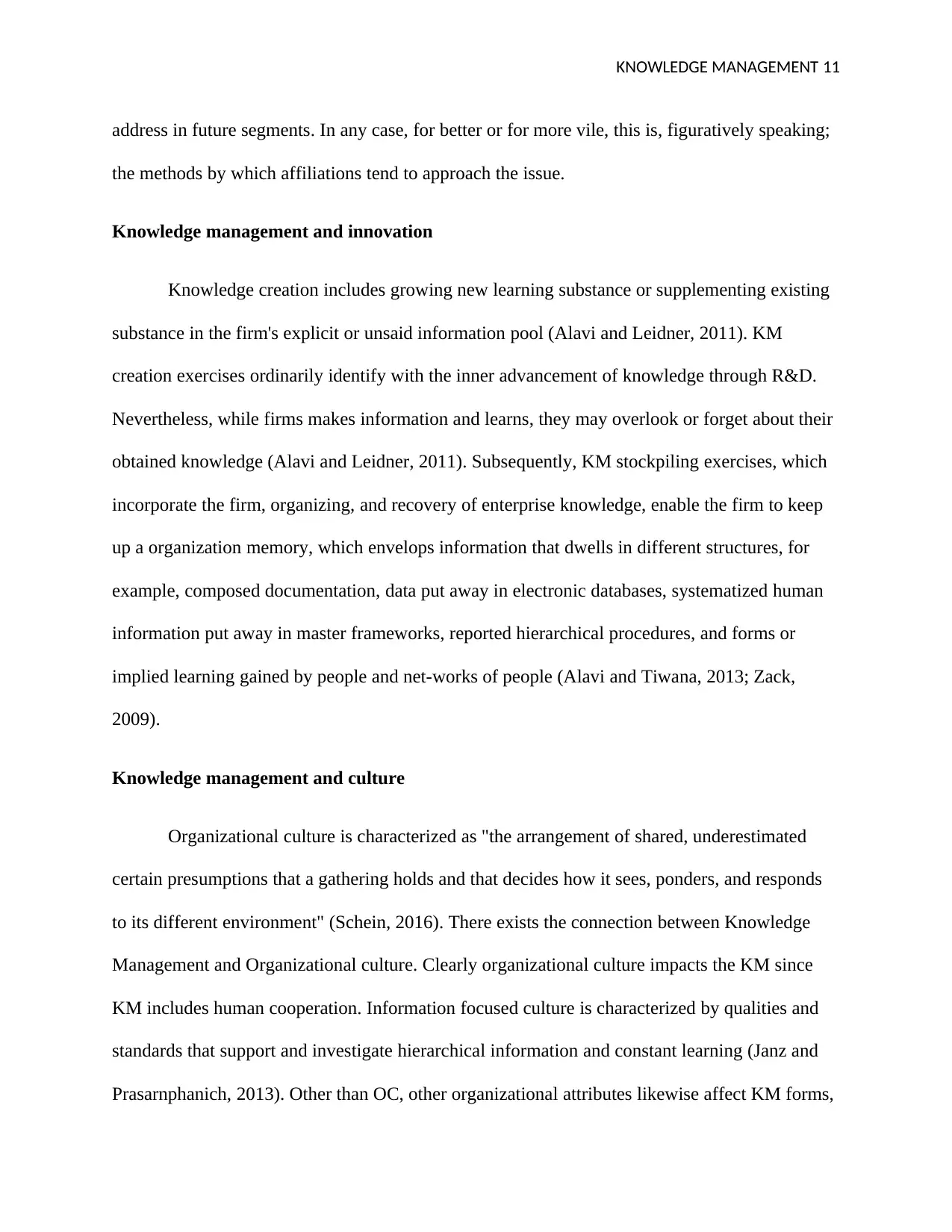
KNOWLEDGE MANAGEMENT 11
address in future segments. In any case, for better or for more vile, this is, figuratively speaking;
the methods by which affiliations tend to approach the issue.
Knowledge management and innovation
Knowledge creation includes growing new learning substance or supplementing existing
substance in the firm's explicit or unsaid information pool (Alavi and Leidner, 2011). KM
creation exercises ordinarily identify with the inner advancement of knowledge through R&D.
Nevertheless, while firms makes information and learns, they may overlook or forget about their
obtained knowledge (Alavi and Leidner, 2011). Subsequently, KM stockpiling exercises, which
incorporate the firm, organizing, and recovery of enterprise knowledge, enable the firm to keep
up a organization memory, which envelops information that dwells in different structures, for
example, composed documentation, data put away in electronic databases, systematized human
information put away in master frameworks, reported hierarchical procedures, and forms or
implied learning gained by people and net-works of people (Alavi and Tiwana, 2013; Zack,
2009).
Knowledge management and culture
Organizational culture is characterized as "the arrangement of shared, underestimated
certain presumptions that a gathering holds and that decides how it sees, ponders, and responds
to its different environment" (Schein, 2016). There exists the connection between Knowledge
Management and Organizational culture. Clearly organizational culture impacts the KM since
KM includes human cooperation. Information focused culture is characterized by qualities and
standards that support and investigate hierarchical information and constant learning (Janz and
Prasarnphanich, 2013). Other than OC, other organizational attributes likewise affect KM forms,
address in future segments. In any case, for better or for more vile, this is, figuratively speaking;
the methods by which affiliations tend to approach the issue.
Knowledge management and innovation
Knowledge creation includes growing new learning substance or supplementing existing
substance in the firm's explicit or unsaid information pool (Alavi and Leidner, 2011). KM
creation exercises ordinarily identify with the inner advancement of knowledge through R&D.
Nevertheless, while firms makes information and learns, they may overlook or forget about their
obtained knowledge (Alavi and Leidner, 2011). Subsequently, KM stockpiling exercises, which
incorporate the firm, organizing, and recovery of enterprise knowledge, enable the firm to keep
up a organization memory, which envelops information that dwells in different structures, for
example, composed documentation, data put away in electronic databases, systematized human
information put away in master frameworks, reported hierarchical procedures, and forms or
implied learning gained by people and net-works of people (Alavi and Tiwana, 2013; Zack,
2009).
Knowledge management and culture
Organizational culture is characterized as "the arrangement of shared, underestimated
certain presumptions that a gathering holds and that decides how it sees, ponders, and responds
to its different environment" (Schein, 2016). There exists the connection between Knowledge
Management and Organizational culture. Clearly organizational culture impacts the KM since
KM includes human cooperation. Information focused culture is characterized by qualities and
standards that support and investigate hierarchical information and constant learning (Janz and
Prasarnphanich, 2013). Other than OC, other organizational attributes likewise affect KM forms,
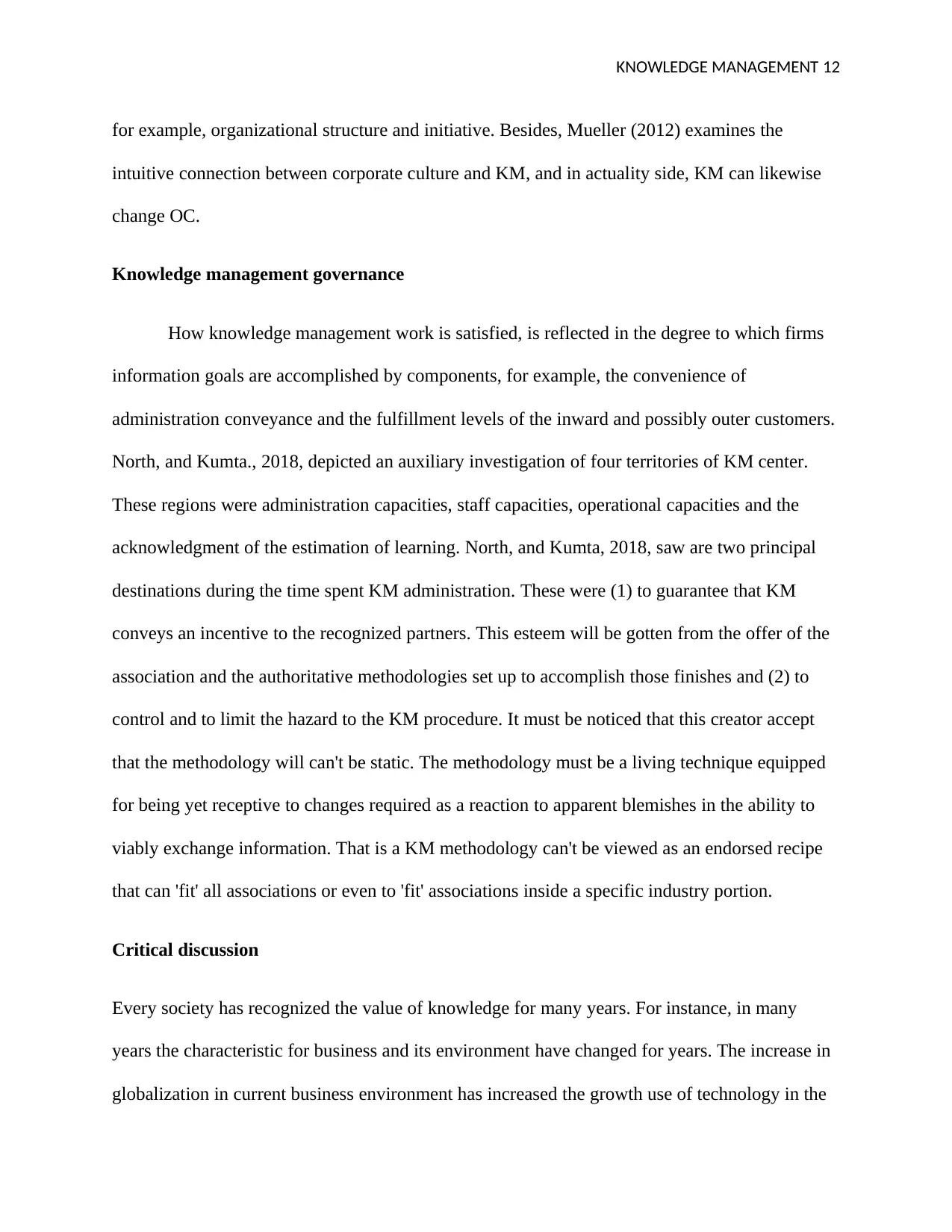
KNOWLEDGE MANAGEMENT 12
for example, organizational structure and initiative. Besides, Mueller (2012) examines the
intuitive connection between corporate culture and KM, and in actuality side, KM can likewise
change OC.
Knowledge management governance
How knowledge management work is satisfied, is reflected in the degree to which firms
information goals are accomplished by components, for example, the convenience of
administration conveyance and the fulfillment levels of the inward and possibly outer customers.
North, and Kumta., 2018, depicted an auxiliary investigation of four territories of KM center.
These regions were administration capacities, staff capacities, operational capacities and the
acknowledgment of the estimation of learning. North, and Kumta, 2018, saw are two principal
destinations during the time spent KM administration. These were (1) to guarantee that KM
conveys an incentive to the recognized partners. This esteem will be gotten from the offer of the
association and the authoritative methodologies set up to accomplish those finishes and (2) to
control and to limit the hazard to the KM procedure. It must be noticed that this creator accept
that the methodology will can't be static. The methodology must be a living technique equipped
for being yet receptive to changes required as a reaction to apparent blemishes in the ability to
viably exchange information. That is a KM methodology can't be viewed as an endorsed recipe
that can 'fit' all associations or even to 'fit' associations inside a specific industry portion.
Critical discussion
Every society has recognized the value of knowledge for many years. For instance, in many
years the characteristic for business and its environment have changed for years. The increase in
globalization in current business environment has increased the growth use of technology in the
for example, organizational structure and initiative. Besides, Mueller (2012) examines the
intuitive connection between corporate culture and KM, and in actuality side, KM can likewise
change OC.
Knowledge management governance
How knowledge management work is satisfied, is reflected in the degree to which firms
information goals are accomplished by components, for example, the convenience of
administration conveyance and the fulfillment levels of the inward and possibly outer customers.
North, and Kumta., 2018, depicted an auxiliary investigation of four territories of KM center.
These regions were administration capacities, staff capacities, operational capacities and the
acknowledgment of the estimation of learning. North, and Kumta, 2018, saw are two principal
destinations during the time spent KM administration. These were (1) to guarantee that KM
conveys an incentive to the recognized partners. This esteem will be gotten from the offer of the
association and the authoritative methodologies set up to accomplish those finishes and (2) to
control and to limit the hazard to the KM procedure. It must be noticed that this creator accept
that the methodology will can't be static. The methodology must be a living technique equipped
for being yet receptive to changes required as a reaction to apparent blemishes in the ability to
viably exchange information. That is a KM methodology can't be viewed as an endorsed recipe
that can 'fit' all associations or even to 'fit' associations inside a specific industry portion.
Critical discussion
Every society has recognized the value of knowledge for many years. For instance, in many
years the characteristic for business and its environment have changed for years. The increase in
globalization in current business environment has increased the growth use of technology in the
⊘ This is a preview!⊘
Do you want full access?
Subscribe today to unlock all pages.

Trusted by 1+ million students worldwide
1 out of 16
Related Documents
Your All-in-One AI-Powered Toolkit for Academic Success.
+13062052269
info@desklib.com
Available 24*7 on WhatsApp / Email
![[object Object]](/_next/static/media/star-bottom.7253800d.svg)
Unlock your academic potential
Copyright © 2020–2025 A2Z Services. All Rights Reserved. Developed and managed by ZUCOL.





